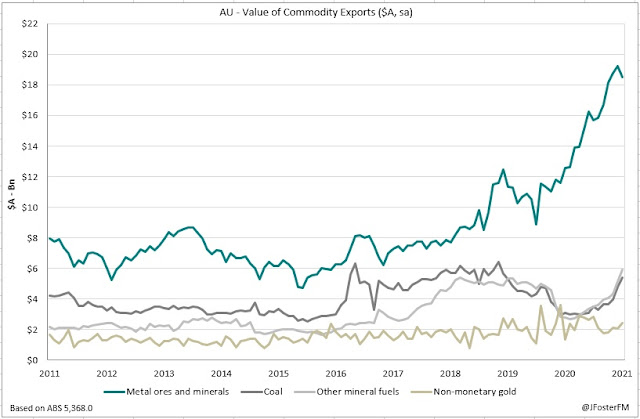The surplus on Australia's monthly trade account has reset to a new record high for the third month running rising to $15.1bn in August. Despite iron ore posting its first decline since February, gains in other commodities and rural goods kept the surge in export earnings rolling. Imports slowed for the first time since April and are potentially showing some signs of the input shortages and bottlenecks impacting global supply chains.
International Trade — August | By the numbers
- Australia's monthly trade surplus lifted by $2.4bn in August to a new record high of $15.1bn, well exceeding the consensus estimate of $10.1bn. July's surplus was revised higher, from $12.1bn to $12.7bn.
- Export earnings advanced by 4.1% (prior: 4.9%m/m) to $48.52bn — another record level — to be 47.6% higher over the year.
- Import spending pulled back by 1.5% in the month after rising by 3.6% in July. This brought imports to $33.45bn, for annual growth of 11%.
International Trade — August | The details
The widening in Australia's trade surplus extended north of $15bn in August, defying market expectations for a narrowing to around $10bn. Australia has benefitted from the reopening of economies offshore with demand for its key commodities rising, pushing prices to elevated levels and driving export earnings to record highs. This has easily ouptaced the rebound in import spending generated by the recovery in the domestic economy. These factors have widened the trade surplus by a stunning $8.4bn since its recent low in March.
Export earnings were 4.1% higher in August at $48.5bn, continuing its record run for a third month. The largest contribution came from non-rural goods (3.3%m/m), even as iron ore exports declined (-3.8%) for the first time in 6 months as prices came off their recent highs.
Rising prices in other commodities more than offset the iron ore decline, with exports of coal, coke and briquettes (12.7%), other mineral fuels (15.7%) and metals (23.9%) all on the rise.
Rural goods advanced strongly in the month, up 11.3% to a record $5.4bn. Sharp gains were seen across the category; meat 6.6%, cereals 16.7%, wool 59.3% and 'other' goods 2.1%.
Non-monetary gold added weight to export earnings rising by 3.5% in August. Services exports were little changed in the month (-2.6%) and remained at low levels reflecting the closure of the international borders to offshore tourists.
Turning to imports, spending was down by 1.5% in August, making this its weakest outturn since April. Still, at $33.4bn import spending is 11% higher than around the depths of the first wave of the pandemic a year ago.
Weighing on imports in the month was intermediate goods which fell 6.5%, the category's sharpest decline in nearly a year. That was driven by parts for capital goods (-42.9%) coming down from a surge in the month prior. After a sharp run-up of late, primary industrial supplies were also well down on the month (-28.1%). Capital goods posted a 4% decline in August as weakness from the prior month (-0.2%) accelerated. That included declines in telecommunications equipment (-2.1%), industrial transport equipment (-7.2%) and other goods (-35.9%). These declines may be pointing to the impacts of the input shortages and bottlenecks evident in global supply chains.
Consumption goods (4.3%m/m) saw a rebound after declines in the past two months to be up 4.6% over the year. That was led by non-industrial transport equipment lifting 12%m/m (39%yr) as demand for passenger vehicles remains very strong. Services imports lifted by a modest 1.2%m/m and are substantially below pre-pandemic levels with offshore travel prohibited.
International Trade — August | Insights
Another record high on the monthly trade surplus, though with iron ore prices well down from their earlier highs a narrowing appears in prospect. Uncertainty is a factor on the import side amid a domestic reopening from the Delta outbreaks and the constraints in global supply chains pushing prices higher.






